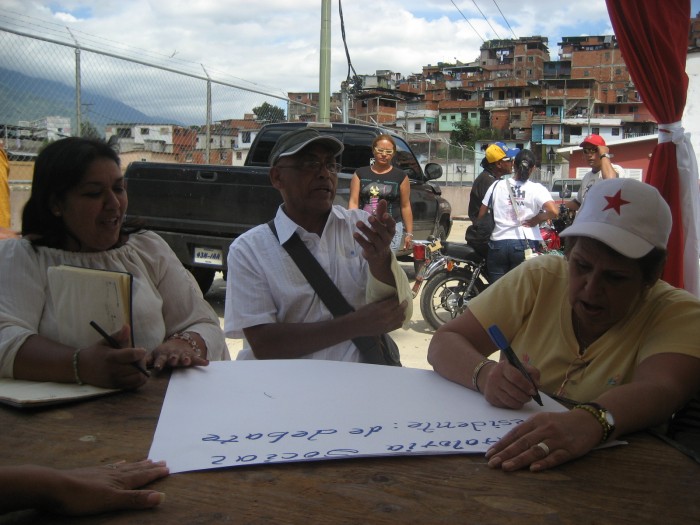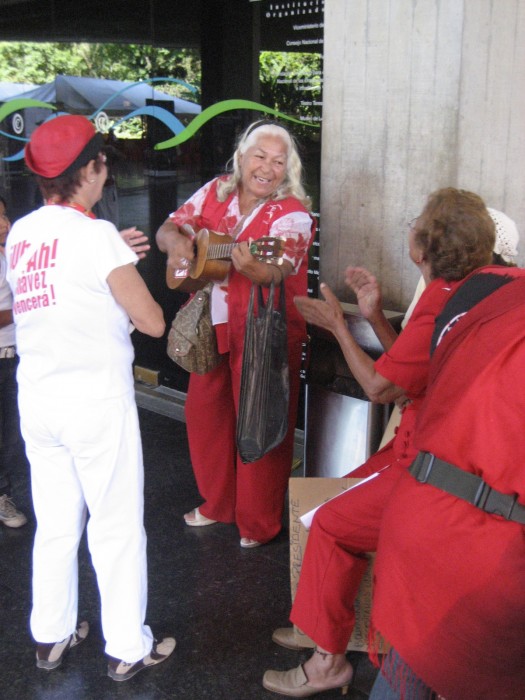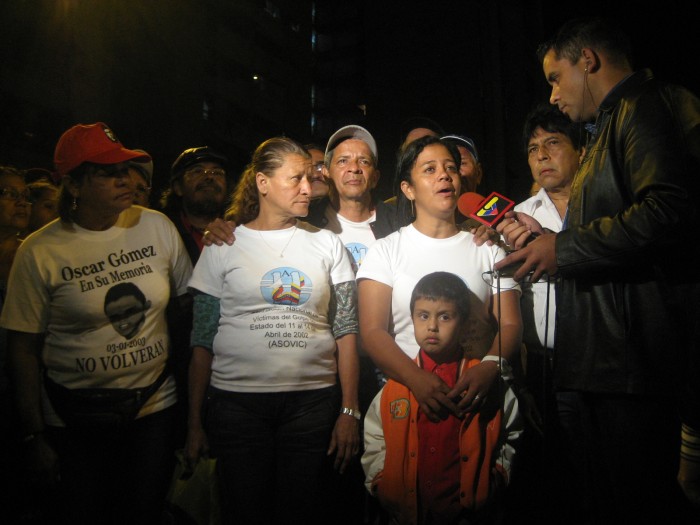This post is part of a series on the Latin American pink tide, moderated and edited by Massimiliano Mollona (Goldsmiths, University of London).
I still clearly remember Margarita,[1] the first “Bolivarian activist” I got to know in Venezuela. It seems so long ago now. For more than ten years, I have followed what I in my mind envisage as the rise and fall of the Bolivarian Revolution’s golden years as seen from the grassroots’ perspective. My first encounter with President Hugo Chávez’s Venezuela was in the fall of 2005, when I as a master’s student in Anthropology of Development came to Caracas for the first time. Through a friend of an acquaintance of an acquaintance, I was brought to the barrio (shantytown) of La Vega to meet with a group of women engaged in a housing and infrastructure project through the recently established Committees for Urban Housing (Comités de Tierra Urbana).
A busy revolutionary bee
Margarita was a retired travel agency assistant who was snapped out from her ordinary wife, mother, and grandmother life when she felt the calling to throw herself into the swelling and increasingly bold and optimistic ranks of community activists in her neighborhood. I still remember the sound of her blue flip-flops as we strolled through the busy and dusty streets of La Vega on our way to visit a fellow activist or join a community meeting. Margarita must have been at least 30 centimeters shorter than I, her sharp cheekbones and smooth, light brown skin revealing her indigenous heritage. She usually didn’t say much in meetings, but she worked diligently alongside her fellow activists, and her body language and quick, ”flip-flop, flip-flop, flip-flop” steps revealed that she felt like a busy bee—a woman with a mission.
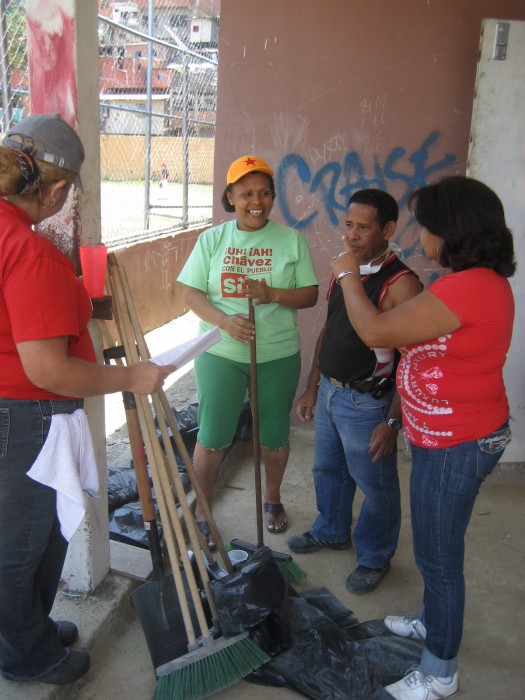
A group of community activists in the parish of 23 de Enero cleaning up an abandoned hospital site in 2009.
One of my most powerful ethnographic moments came when she told me of the first time she entered a public office to have a meeting with a public official. This had not been part of her world throughout her fifty-something years, the formal and political spaces of the Venezuelan state had previously had nothing to do with her. It was the world of “the others”—the people of formal and legitimate Caracas. Margarita’s community hadn’t even been drawn up on the city map, and her world had been her job, her family and her immediate neighborhood. Not anymore. Now she spent her days roaming across La Vega, visiting other barrios, joining marches and demonstrations, meeting other activists, petitioning public offices, discussing with politicians. Now she was in service of the Bolivarian revolution and the transformation of her fatherland no less.
Multitudes of Margaritas
Since then, I have met probably a couple of hundreds of Margaritas. Some have become long-time friends and/or steady “informants,” others have become acquaintances who vaguely remember me when I return to Caracas, others I have lost contact with or only spoken with in passing during a meeting or demonstrations. But I remember many of them. The grandmother who joined night classes in Mision Ribas[2] and who aspired to continue with Mision Sucre[3] and study law. The middle-aged mother who renounced her office job after the 2002 coup “because the boss was an esqualido[4] and talked shit about Chávez” and signed up for an unpaid training program over several months in order to become a public official working in the barrios to assist the communal councils.[5] The stunningly beautiful sociology student from a dirt-poor home who worked around the clock to enroll women into the Mision Madres de Barrio.[6] The street-smart, stashed-up teenage girls who started a hip-hop group, singing and dancing to self-composed lyrics about poverty, injustice, and violence.
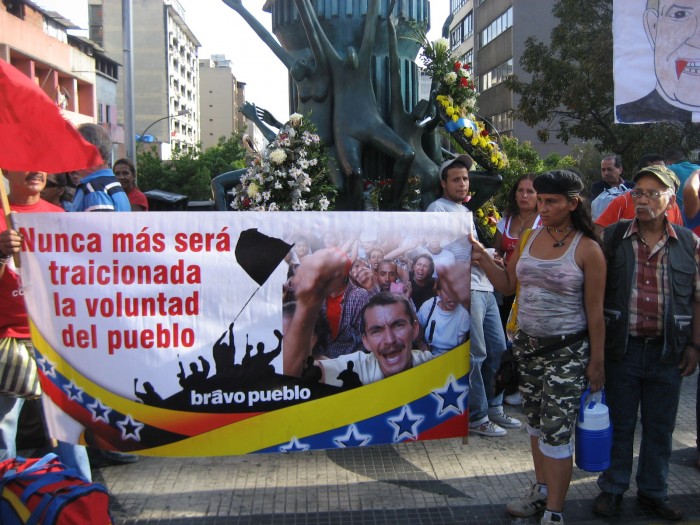
Mass gathering in memorial of the 2002 coup. The banner reads, “The will of the people shall not be betrayed again” (14 April 2009).
And the men—the warm-hearted, 60-year-old bachelor who broke his back organizing the rehabilitation of houses in his community while his own roof was literally starting to fall down over his head. The life-long political activist who spent his afternoons and evenings organizing sports activities for youth in his neighborhood, hoping this would keep them out of trouble. The clear-eyed young student in public administration who took classes in human rights and participated in community activism at night, aspiring to join the municipal administration one day and to do good from within the system. These people and their comrades were the backbone of the Bolivarian Revolution’s golden years.
Real politik and social change
When I was invited to write this blog post, I first wanted to do a sober analysis of Venezuela’s current political and economic turbulence, starting with how Chávez’s death unsettled the Bolivarian political agenda and how Nicolás Maduro’s government blundered with replicating Chávez’s popular appeal and political sense of direction. I wanted to highlight how political opaqueness, centralization, and intensifying talk of corruption (Gupta 1995) seriously undermined the political-moral foundation for the Bolivarian project. I wanted to point out how the Venezuelan political opposition finally got its act together and managed to mobilize enough political capital to get back in business, well aided by the government’s inability to contain the economic crisis. I also wanted to problematize whether voters really want the opposition and their rather muddy political agenda, or if they are just disappointed and angry with the government.
And I wanted to link these discussions about Venezuela to an analysis of how important sectors of the Latin American right have backed each other up across borders, surely well helped by advisors, allies, and media pundits from a bouquet of conservative forces across and beyond the continent, and how all of these trajectories were aided by the slumping oil prices and ensuing economic hardships. I wanted to round off with some well-articulated reflections on how Venezuela’s rise and fall once again seemed to be tied to fluctuations in global oil markets, and how political scientists, economists, and political journalists now are polishing their keyboards to chew out eloquent analyses of how the oil-fueled populist Chávez/Maduro regime was bound to end in an state of disarray. I would conclude with some observations about their shortcomings myself (though carefully avoiding both historical determinism and political fatalism) and point out how my own work (Strønen 2012, 2014, forthcoming) has problematized the inherent difficulties in not only altering political and economic structures entrenched in international political economies and architectures of power but also changing accumulated socio-economic inequalities, political cultures, and oil-fueled imageries of wealth.
The real revolution
But I couldn’t make myself write it. I find this level of analysis intriguing and interesting, by all means, and there is certainly a huge job to be done for academics across the board to come up with an in-depth understanding of how Latin America went from the pink tide époque to a post-pink tide époque. We have to do substantive unpacking of real politik in all its political and economic dimensions, as well as in-depth comparative analysis of conditions and impediments for deep social and political change.
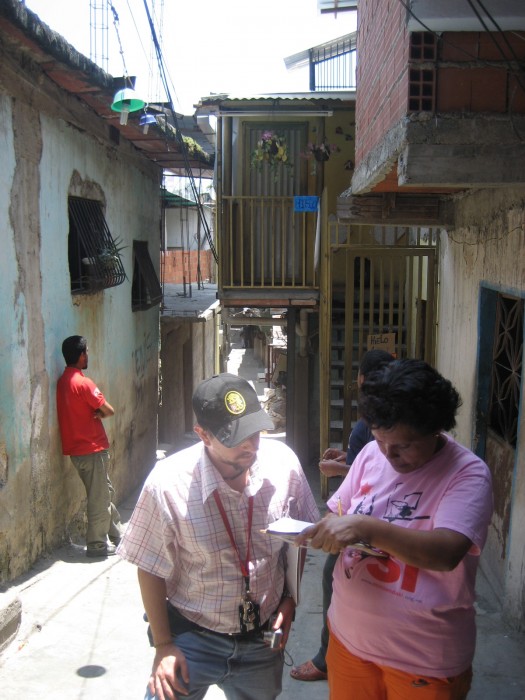
Public officials from the municipal administration and activists making inspections of housing conditions in the parish of 23 de Enero.
However, for now, I wanted to put Margarita and the others into focus, because they, also in the course of the Bolivarian Revolution, so often were shunted aside when the big political picture was to be drawn up. Anthropologists, grassroots media, and social activists repeatedly showed how the “true revolution” went far beyond the figure of Chávez and rather consisted of the explosive upsurge of community activism and cultural politics from below. In the golden years of the Bolivarian Revolution, Caracas teemed with optimism, activism, and sheer revolutionary fervor. The stigma of poverty and pigmented skin was summoned to contest, public TV aired debates among political activists sitting on plastic chairs on a barrio corner, and people gathered around drums, guitars, and the usual bottles of liquor and beer to toast for “la revolución.” There was never any naivety; people knew what they were up against. No one thought it would be an easy fix—to change the country’s historical structural legacy, to change people’s hearts and minds, to reverse entrenched inequalities, to sow the oil, to counter the attacks from the right. The most they could hope for was that their children and grandchildren would live in a “better Venezuela.” But there was optimism, and there was a remarkable increased sense of dignity, that little word which those who never had their dignity disputed do not really comprehend but which is so fundamental for those who have experienced to have theirs denied or unsettled.
Who will talk to Margarita?
So when I saw the victory photo of Henry Ramos Allup (general secretary of the opposition party Acción Democrática and now president of the National Assembly) where he makes a cutthroat gesture with a spiteful expression on his face, I immediately recalled Margarita. Ramos Allup, a quintessential member of what people often refer to as “the dinosaurs of the Fourth Republic”[7] and whom United States ambassador William Brownfield in a WikiLeaks cable described as “unimaginative, overconfident, and even repellent” as well as “crude, abrasive, arrogant, [and] thin-skinned.” And I thought to myself, what does the future have in store for the hundreds of thousands or even millions of Margaritas?
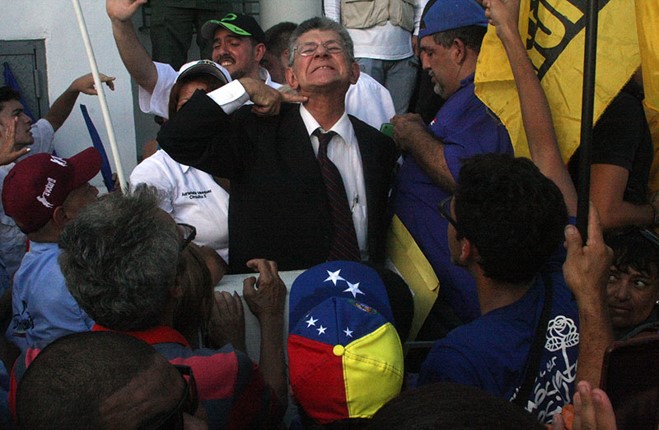
Photo by Juan Carlos Neira (Sumarium, 9 December 2015)
Many or most of them are probably out of community politics by now. Activist ranks have shrunk over the years. Mobilization fatigue, bureaucracy, conflicts, opportunism, and a de-ideologization of community politics gradually took its toll, and then came the economic crisis. But they are still there, in Venezuela’s barrios with their pigmented skin, indigenous traits, faded T-shirts, and blue flip-flops, many of them still holding onto the ideals of the Bolivarian Revolution and bracing themselves for the return of the right. And regardless of it all, a lot more conscious than they were before, and certainly unwilling to return to the times when they had to bow their head for condescending middle- and upper-class power. What will be their place in Venezuelan society if, or when, the opposition ushers into government offices in one way or the other, bent on reconsolidating the economic, political, social, and cultural power they so much long for and so deeply feel entitled to?
After the revolution
So my concluding thoughts are these: the Chávez and Maduro governments had a range of flaws, which undoubtedly contributed to the rise and fall of the Bolivarian Revolution’s golden years. And evidently, regardless of who and what is to blame, the current economic situation is not sustainable over time. That does not, however, mean that what comes next will be a sweet sight for sore eyes, above all not from the barrio inhabitants’ point of view.
Because what the Bolivarian process did do, and which is important to remember even as the future of the Bolivarian Revolution seems bleaker than ever, was to open up a space of action, negotiation, and articulation where Venezuela’s Margaritas (and Juans) could take up more space than they ever had before in Venezuelan history. It gave them a push for reshaping political and social identities, and a state/government that—in spite of “its” (in an anthropological, Blom-Hansen and Stepputat 2001 sense) enormous incongruity, heterodoxy, faults, shortcomings, and frequent double-speech—rendered visible the poor, colored Venezuela and its structural underpinnings.
Time will show if Ramos Allup and his likes will reach out to the Margaritas of Venezuela. If history is anything to go by, they won’t. And therein lies the task of anthropologists, since it is our business to zoom in on people’s lives behind the broad sweeps of history, to capture and explain not only all the Margaritas’ journey through the rise and fall of the Bolivarian Revolution’s golden years but also what the possible future of the counterrevolution has in store for them.
Iselin Åsedotter Strønen is an Associated Professor at the Department for Social Anthropology, University of Bergen, and an affiliated researcher at the Chr. Michelsen Institute (CMI). She wrote her PhD dissertation on community activism, state reforms, and the cultural politics of oil in Venezuela, and is the co-maker of the documentary film The People and the President: A Portrait of the Bolivarian Revolution (Strønen and Wærness 2007). Within the past ten years, she has lived more than two years in Venezuela, most of the time in Caracas’s western shantytowns.
Notes
[1] Margarita is a pseudonym.
[2] Mision Ribas is the high school level government educational program, catering particularly to high school dropouts and adults. The majority of the students have been women.
[3] Mision Sucre is the higher education government educational program, catering particularly to underprivileged students.
[4] A term that in Bolivarian discourse refers to the opposition and its supporters—plays on the word “squalid.”
[5] Communal Councils (Consejos Comunales) are state-supported neighborhood organs that are legally constituted by local popular vote and entitled to plan and execute local development projects (funded by the government) and a range of other tasks.
[6] Mision Madres de Barrio is a material support and job-training program aimed a poor mothers.
[7] The political epoche (1958–1998) prior to Chávez is often referred to as the Fourth Republic, while the era after Chávez’s electoral victory is called the Fifth Republic. The Forth Republic is often also referred to as “Puntofijismo” after the political pact made between Acción Democratica and the social democratic COPEI in the city of Punto Fijo in 1958, and which underwrote their political hegemony for the next forty years.
References
Blom-Hansen, Thomas, and Finn Stepputat. 2001. States of imagination: Ethnographic explorations of the postcolonial state. Durham, NC: Duke University Press.
Gupta, Akhil. 1995. Blurred boundaries: The discourse of corruption, the culture of politics, and the imagined state. In A. Sharma and A. Gupta, eds., The anthropology of the state: A reader. Oxford: Blackwell Publishing.
Strønen, Iselin Åsedotter. Forthcoming. Everyday crafting of the Bolivarian state: Lower-level public officials and grassroots activism in Venezuela. Latin American Perspectives. Special issue on the legacy of Hugo Chávez.
Strønen, Iselin Åsedotter. 2014. The revolutionary petro-state: Change, continuity and popular power in Venezuela. PhD dissertation, University of Bergen.
Strønen, Iselin Åsedotter. 2011. Development from below and oil money from above. Popular organization in contemporary Venezuela. In J.A. McNeish and O. Logan, eds., Flammable societies: Studies on the socio economics of oil and gas. London: Pluto Press.
Cite as: Strønen, Iselin Åsedotter. 2016. “After the Bolivarian Revolution: What’s in store for Margarita?” FocaalBlog, 1 April. www.focaalblog.com/2016/04/01/iselin-asedotter-stronen-after-the-bolivarian-revolution-whats-in-store-for-margarita.
